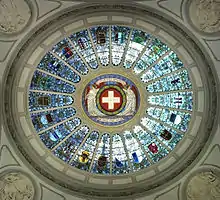Canton of Geneva
The Canton of Geneva, officially the Republic and Canton of Geneva (French: République et canton de Genève; Francoprovençal: Rèpublica et canton de Geneva; German: Republik und Kanton Genf; Italian: Repubblica e Cantone di Ginevra; Romansh: Republica e chantun Genevra), is one of the 26 cantons forming the Swiss Confederation. It is composed of forty-five municipalities and the seat of the government and parliament is in the City of Geneva.
Canton of Geneva | |
|---|---|
| Republic and Canton of Geneva | |
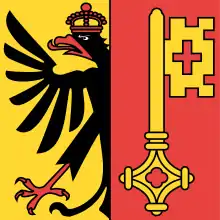 Flag Coat of arms | |
| Motto(s): Post Tenebras Lux | |
| Anthem: Cé qu'è lainô | |

Location in Switzerland
Map of Geneva 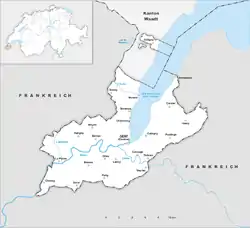 | |
| Coordinates: 46°2′N 6°7′E | |
| Capital | Geneva |
| Subdivisions | 45 municipalities |
| Government | |
| • Executive | Conseil d'État (7) |
| • Legislative | Grand Council (100) |
| Area | |
| • Total | 282.49 km2 (109.07 sq mi) |
| Population (December 2019)[2] | |
| • Total | 504,128 |
| • Density | 1,800/km2 (4,600/sq mi) |
| ISO 3166 code | CH-GE |
| Highest point | 516 m (1,693 ft): Les Arales |
| Lowest point | 332 m (1,089 ft): Rhône at Chancy |
| Joined | 1815 |
| Languages | French |
| Website | www |
Geneva is the French-speaking westernmost canton of Switzerland. It lies at the western end of Lake Geneva and on both sides of the Rhone, its main river. Within the country, the canton shares borders with Vaud to the east, the only adjacent canton. However, the borders of the canton are essentially international, with the French region of Auvergne-Rhône-Alpes. As is the case in several other Swiss cantons (Ticino, Neuchâtel, and Jura), Geneva is referred to as a republic within the Swiss Confederation.
One of the most populated cantons, Geneva is considered one of the most cosmopolitan regions of the country. As a center of the Calvinist Reformation, the city of Geneva has had a great influence on the canton, which essentially consists of the city and its suburbs. Notable institutions of international importance based in the canton are the University of Geneva, the United Nations and CERN.
History
Early history
Geneva was controlled by the Allobroges tribe until 121 BC. It was then annexed to the Roman Empire in 121 BC and remained part of it until 443, after which the Burgundians took over the city. In 532, the land controlled by Burgundians became part of the Frankish Empire and the city became a part of the Kingdom of Burgundy in 888. By 1032 Geneva became a part of the Holy Roman Empire and officially remained in it until the Peace of Westphalia.
The Prince-Bishopric of Geneva was a prince-bishopric of the Holy Roman Empire from 1154, but from 1290, secular authority over the citizens was divided from the bishop's authority, at first only lower jurisdiction, the office of vidame given to François de Candie in 1314, but from 1387 the bishops granted the citizens of Geneva full communal self-government.
As from 1416, the Dukes of Savoy attempted to annex the city, both by claiming secular authority and by installing members of the Savoy dynasty as bishops, the city sought assistance in allying itself with the Old Swiss Confederacy.
Republic of Geneva (1534/1541–1798, 1813–1815)
The Republic of Geneva existed, depending on sources, either from 1534,[3] or from November 30, 1541,[4] when the General Council ratified the ecclesiastical ordinances of John Calvin, until April 26, 1798, when it was annexed by France, and then from December 31, 1813, until May 19, 1815, during the Restauration of the Republic. It was given a constitution (Édits civils) in 1543, and it effectively functioned as a Protestant theocracy. The Republic of Geneva reinforced its alliance to the Protestant cantons of the Swiss Confederacy, becoming an "everlasting ally" in 1584.
The French Revolution reached Geneva in 1792, and in February 1794, the Republic gave itself a new, revolutionary constitution which proclaimed the equality of all citizens. After the death of Robespierre in July of the same year, there was a counter-revolution, which gained the upper hand by 1796.
Modern history
Robespierre's death prompted the French invasion of 1798, and the annexation of Geneva which became the capital of the French département du Léman. The Napoleonic army left Geneva on December 30, 1813, and on the next day the return of the Republic (Restauration de la République) was proclaimed.
Geneva finally joined the Swiss Confederation in 1815 as the 22nd canton. The territory of the present canton of Geneva was largely established as a result of the Congress of Vienna, in order to provide contiguity between the city of Geneva and its satellite territories such as Satigny, and to physically join the canton to the rest of Switzerland.
From France, the canton added the current municipalities of Versoix (which provided the geographical link with neighbouring Vaud), Collex-Bossy, Pregny-Chambésy, Vernier, Meyrin and Grand-Saconnex. From Sardinia, the canton gained the present municipalities of Laconnex, Soral, Perly-Certoux, Plan-les-Ouates, Bernex, Aire-la-Ville, Onex, Confignon, Lancy, Bardonnex, Compesières, Troinex, Veyrier, Chêne-Thônex, Puplinge, Presinge, Choulex, Meinier, Collonge-Bellerive, Corsier, Hermance, Anières, and Carouge. [5]
The last change of the canton's borders occurred in 1956. As a result of the planned expansion of Geneva Airport, France and Switzerland agreed to exchange a piece of territory to fit in the new runway. [6]
Coat-of-arms
The elements of the coat-of-arms are:
- Shield: showing the Imperial Eagle and a Key of St. Peter (symbolizing the status of Geneva as Reichsstadt and as episcopal seat, respectively), in use since the 15th century.
- Crest in the form of half a sun inscribed with ΙΗΣ (for Jesus Hominum Salvator)
- The motto: Post Tenebras Lux
 Full Genevan flag
Full Genevan flag Full coat-of-arms of the Republic and Canton of Geneva, with the crest, shield, and motto[7]
Full coat-of-arms of the Republic and Canton of Geneva, with the crest, shield, and motto[7]
The current coat-of-arms, adopted from the city of Geneva, represent the union of the semi-Eagle originating from the two-headed eagle from the Holy Roman Empire, of which Geneva formed part since the Middle Ages, and the gold key from the coat-of-arms of the bishopric of Geneva, symbolising the Key of St. Peter, patron saint of the cathedral. The bishop was a direct vassal of the emperor and he exercised in his name the temporal power over the city. Symbolising the union of spiritual and mortal powers, the coat-of-arms were adopted by the citizens of Geneva in 1387. The old colours of Geneva were the gray and the black. Then the black and purple in the 17th century. The gold and red began to be used from the 18th century.
The crest with the sun and the ΙΗΣ inscription, denoting the first three letters of the Greek name of Jesus, exists since the 15th century, but it wasn't used on the coat-of-arms until the 16th century.
The motto of Geneva, Post Tenebras Lux, stands in latin for "light after darkness", appears in the Vulgate version of Job 17:12. The phrase was adopted as the Calvinist motto, and it was then adopted by the entire Protestant reformation and by Geneva.
Geography
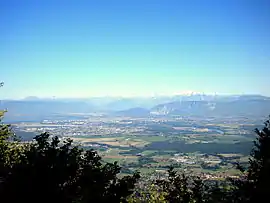
Geneva is the flattest canton of Switzerland, with a height difference of only 184 metres between its lowest and highest point. However, it is surrounded across its borders by the numerous mountains of the Jura and Alpine foothills, notably the Salève (in French territory) and La Dôle (in Vaud territory). The area of the canton of Geneva is 282 square kilometers (108.9 sq mi). The canton of located in the extreme west of Switzerland. Excluding the exclave of the municipality of Céligny, the canton shares 95% of its border with France: 103km out a total of 107.5km, the remaining 4.5km are shared with Vaud.
Geneva is surrounded by the French departments of the Ain to its west, and that of the Haute Savoie to the East and South, and the canton of Vaud to the north.
The canton is located in the Genevan basin. The region is bordered by the Lake Geneva and traversed by the major rivers of the Rhone flowing out of the lake and the Arve, whose source is located in the Mont-Blanc region. It is encircled by the Jura on its north-west; by the Vuache to its west, split from the Jura by the Rhone valley and protected by the Fort l'Écluse; by the Mont-de-Sion to the South; by the Salève to the south-east, a mountain locals refer to as the “mountain of Genevans" despite being located in France due to its easy access and proximity; and to the east are the Alps, whose highest peak, the Mont-Blanc, is often visible from many parts of the canton. North-East from Salève, in Monniaz (municipality of Jussy), is located the highest point of the canton at 516 metres above sea level. The lowest point of the canton is the Rhone south of Chancy at 332 metres.
The main characteristic of the canton is its common mixture of the urban landscape of the city of Geneva and its surrounding towns, and a well-preserved rural landscape. The Mandement, in the north-west of the canton, is a partial valley dug by the river Allondon, a tributary of the Rhone, and regrouping the major wine-making towns of Satigny, Russin, and Dardagny. The Verbois dam built over the Rhone in that area supplies around 15% of the electricity needs of the canton and it links the Mandement to Champagne, on the opposite side of the river, between the towns of Russin and Aire-la-Ville.
Chancy, the westernmost municipality of Switzerland, is located in Champagne. The slope raises gently from the Rhone towards the main town of the region, Bernex, culminating in the Signal at 509.9 metres, the second-highest point of the canton. This region contains several historical villages such as Sézegnin, Athenaz, Avusy, Laconnex, Soral, Cartigny, and Avully, transferred to Geneva from the Duchy of Savoy in 1815.
Politics
Municipalities

There are 45 municipalities in the canton (As of 2017).[8]
Geneva does not have any administrative districts. There are 13 cities with a population of over 10,000 as of 2019:[2]
- Genève, 203,951 residents
- Vernier, 34,958 residents
- Lancy, 33,377 residents
- Meyrin, 25,745 residents
- Carouge, 22,621 residents
- Onex, 19,058 residents
- Thônex, 14,182 residents
- Versoix, 13,411 residents
- Le Grand-Saconnex, 12,275 residents
- Chêne-Bougeries, 12,504 residents
- Veyrier, 11,887 residents
- Plan-les-Ouates, 10,620 residents
- Bernex, 10,244 residents
Government
The constitution of the canton was established in 1847 and has, since then, been amended several times. The cantonal executive government (Conseil d'État) has seven members, who are elected for five years.
The last regular election for the legislation 2018-2023 were held on 15 April 2018 and 6 May 2018.[9]
| Councillor (M. Conseiller d'Etat/ Mme Conseillère d'Etat) | Party | Head of Office (Département, since) of | elected since |
|---|---|---|---|
| Antonio Hodgers[CE 1] | Les Verts (PES) | Département du territoire (DT), 2018 | 2013 |
| Serge Dal Busco[CE 2] | PDC | Département des infrastructures (DI), 2018 | 2013 |
| Anne Emery-Torracinta | PS | Département de l'instruction publique, de la formation et de la jeunesse (DIP), 2013 | 2013 |
| Thierry Apothéloz | PS | Département de la cohésion sociale (DCS), 2018 | 2018 |
| Nathalie Fontanet | LPR | Département des finances et des ressources humaines (DF), 2018 | 2018 |
| Pierre Maudet | LPR | Département du développement économique (DDE), 2019 | 2012 |
| Mauro Poggia | MCG | Département de la sécurité, de l’emploi et de la santé (DSES), 2019 | 2013 |
- President (Président du Conseil d'Etat (PRE)) since 2019
- Vice President (Vice-président) 2019/20
Michèle Righetti is the chancellor of the canton (Chancilière d'Etat) since 2018.
Parliament
Le Grand Conseil of canton of Geneva for the mandate period of 2018-2023[11]
The legislature, the Grand Council (Grand Conseil), has 100 seats, with deputies elected for four years at a time.[12]
The last election was held on 15 April 2018.[13]
In a similar way to what happens at the Federal level, any change to the Constitution is subject to compulsory referendum. In addition, any law can be subject to a referendum if it is demanded by 7,000 persons entitled to vote,[14] and 10,000 persons may also propose a new law.[15]
National Council
The Republique and canton of Geneva has 11 seats in the National Council. On 18 October 2015, in the federal election the most popular party was The Liberals (PLR/FDP) which received three seats with 20.5% of the votes. The next two most popular parties were the Social Democratic Party (PS/SP) with also 3 seats (19.9%), followed by UDC/SVP with two seats (17.6%), and the Christian Democratic People's Party (PDC/CVP) (12.1%), Green Party (PES/GPS) (11.5%), and the Geneva Citizens' Movement (MCG) (7.9%) each with one seat. In the federal election, a total of 106,852 votes were cast, and the voter turnout was 42.9%.[16]
Council of States
On 8/16 November 2015, in the federal election, Councilor Liliane Maury Pasquier, member of the Social Democratic Party (PS/SP), was re-elected in the second round as Conseillère des États of the canton of Geneva with a majority of 44,215 votes. She is part of the Council of States (French: Conseil des États) since 2007. Councilor Robert Cramer, member of the Green Party (PES/GPS), was re-elected in the second round with a majority of 42,075 votes. He is part of the Council of States since 2007.[17]
Federal election results
| Percentage of the total vote per party in the canton in the National Council Elections 1971-2015[18] | ||||||||||||||
|---|---|---|---|---|---|---|---|---|---|---|---|---|---|---|
| Party | Ideology | 1971 | 1975 | 1979 | 1983 | 1987 | 1991 | 1995 | 1999 | 2003 | 2007 | 2011 | 2015 | |
| FDP.The Liberalsa | Classical liberalism | 19.2 | 16.6 | 14.7 | 16.2 | 18.0 | 12.8 | 13.5 | 12.7 | 7.3 | 7.7 | 18.6 | 20.5 | |
| CVP/PDC/PPD/PCD | Christian democracy | 13.8 | 14.7 | 14.0 | 12.3 | 14.6 | 14.5 | 13.4 | 14.1 | 11.8 | 9.7 | 9.8 | 12.1 | |
| SP/PS | Social democracy | 19.1 | 22.6 | 21.5 | 19.2 | 18.6 | 26.4 | 30.0 | 20.0 | 24.8 | 19.1 | 19.1 | 19.9 | |
| SVP/UDC | Swiss nationalism | * b | * | * | * | * | 1.1 | * | 7.5 | 18.3 | 21.1 | 16.0 | 17.6 | |
| LPS/PLS | Swiss Liberal | 14.1 | 16.0 | 21.3 | 19.1 | 18.1 | 22.1 | 17.7 | 18.5 | 16.8 | 14.8 | c | c | |
| Ring of Independents | Social liberalism | 6.2 | 2.4 | * | * | * | * | * | * | * | * | * | * | |
| EVP/PEV | Christian democracy | * | * | * | * | * | * | * | * | * | 1.2 | 1.0 | 0.6 | |
| GLP/PVL | Green liberalism | * | * | * | * | * | * | * | * | * | * | 3.2 | 2.3 | |
| BDP/PBD | Conservatism | * | * | * | * | * | * | * | * | * | * | * | 1.0 | |
| PdA/PST-POP/PC/PSL | Socialism | 20.8 | 18.0 | 19.9 | 9.5 | 8.7 | 7.8 | 9.4 | 8.7 | 2.7 | 1.9 | 1.3 | * | |
| GPS/PES | Green politics | * | * | * | 7.6 | 11.5 | 6.7 | 5.6 | 8.2 | 11.2 | 16.4 | 14.0 | 11.5 | |
| Solidarity | Anti-capitalism | * | * | * | * | * | * | 3.8 | 8.0 | 5.4 | 4.9 | 5.2 | 6.1 | |
| SD/DS | National conservatism | 1.4 | 1.7 | 0.6 | 2.1 | 1.1 | 2.0 | 2.4 | * | * | * | * | * | |
| Rep. | Right-wing populism | 5.4 | 6.9 | 6.5 | 12.2 | 6.9 | d | * | * | * | * | * | * | |
| EDU/UDF | Christian right | * | * | * | * | * | * | * | * | * | * | * | 0.2 | |
| FPS/PSL | Right-wing populism | * | * | * | * | * | 3.0 | * | * | * | * | * | * | |
| Geneva Citizens' Movement (MCR) |
Right-wing populism | * | * | * | * | * | * | * | * | * | * | 9.8 | 7.9 | |
| Other | * | 1.1 | 1.5 | 1.7 | 2.5 | 3.4 | 4.2 | 2.3 | 1.7 | 3.2 | 1.9 | 0.3 | ||
| Voter participation % | 47.0 | 45.4 | 37.6 | 44.5 | 38.6 | 39.6 | 35.6 | 36.3 | 45.9 | 46.7 | 42.4 | 42.9 | ||
Demographics
| Largest groups of foreign residents 2013[2] | ||
| Nationality | Number | % total (foreigners) |
|---|---|---|
| 36,518 | 7.7 (18.8) | |
| 27,231 | 5.7 (14.0) | |
| 20,591 | 4.3 (10.6) | |
| 14,346 | 3.0 (7.4) | |
| 7,440 | 1.6 (3.8) | |
| 4,981 | 1.0 (2.6) | |
| 4,690 | 1.0 (2.4) | |
| 4,637 | 1.0 (2.4) | |
| 3,870 | 0.8 (2.0) | |
| 3,517 | 0.7 (1.8) | |
| 2,263 | 0.5 (1.2) | |
The population of the canton (as of 31 December 2019) is 504,128.[2] As of 2013, the population included 194,623 foreigners from 187 different nations, or about 40.1% of the total population.[2]
The population of the canton, as of December 2013, contained 168,505 people originally from Geneva (35.4%) and 112,878 Swiss from other cantons (23.7%). About 73% of foreigners came from Europe (EU28: 64.4%), 9.1% from Africa, 9.0% from the Americas, and 8.5% from Asia.[2] Including people holding multiple citizenship, 54.4% of people living in Geneva held a foreign passport.[19]
In 2014, the predominant language of Geneva was French, spoken by 81.04% of the population at home; the next largest home languages were English (10.84%), Portuguese (9.89%), Spanish (7.82%) and German (5.32%); respondents were permitted to report more than one language.[20]
_01.jpg.webp)
As home of Calvin's Reformation, the canton of Geneva has traditionally been a Protestant Christian stronghold. However, over the latter part of the 20th century, the proportion of Roman Catholics (220,139 people or 44.5% as of 2017) in the total population rose, in large part due to immigration from Southern Europe, and now they outnumber members of the Swiss Reformed Church (65,629 people or 13.3% as of 2017) in the canton by far; there has also been an increasing tendency in the Swiss population toward becoming religiously unaffiliated.[21] However, the canton is still officially considered Protestant. The surrounding regions of France are mostly Roman Catholic.
In 2012, 5.4% of the Genevan population (aged 15 years and older) belonged to other Christian groups, 5.5% were Muslims, and 5.9% belonged to other religious groups.[22][23] The remainder of the population was religiously unaffiliated or did not answer the census question.
Economy
Despite its relatively small size compared to other Swiss cantons, the canton of Geneva generates the fourth largest GDP of the country (CHF 50bn), behind the cantons of Zurich (CHF 143bn), Berne (CHF 78bn), and Vaud (CHF 54bn),[24] and enjoys the third-largest GDP per capita in the country behind Basel-City and Zug [25]
Geneva's economy is largely service-driven. The canton is often ranked as one of the strongest global financial centres, ranking 9th in the world in 2020[26] and 2nd in Europe behind London. Three main sectors dominate the financial sector: commodity trading; trade finance, and wealth management.
Around a third of the world's free traded oil, sugar, grains and oil seeds is traded in Geneva. Approximately 22% of the world's cotton is traded in the Lake Geneva region. Other major commodities traded in the canton include steel, electricity, or coffee.[27] Large trading companies have their regional or global headquarters in the canton, such as Cargill, Vitol, Gunvor, BNP Paribas, or Mercuria Energy Group, in addition to being home to the world's second largest shipping company, Mediterranean Shipping Company. Commodity trading is sustained by a strong trade finance sector, with large banks such as BCGE, BCP, BNP Paribas, BCV, Crédit Agricole, Credit Suisse, ING, Société Générale, and UBS, all having their headquarters in the area for this business.
Wealth management is dominated by private banks, particularly Pictet, Lombard Odier, Union Bancaire Privée, Mirabaud Group, Dukascopy Bank, Bordier & Cie, Banque SYZ, REYL & Cie, or Edmond de Rothschild Group. In addition, the canton is home to the largest concentration of foreign-owned banks in Switzerland, such as HSBC Private Bank, JPMorgan Chase, or Arab Bank.
Behind the financial sector, the next largest major economic sector is watchmaking, dominated by luxury firms Rolex, Richemont, Patek Philippe, Piaget, Roger Dubuis, and others, whose factories are concentrated in the municipalities of Plan-les-Ouates, Satigny, and Meyrin.
Trade finance, wealth management, and watchmaking, approximately contribute two thirds of the corporate tax paid in the canton[28]
.jpg.webp)
Other large multinationals are also headquartered in the canton, such as Firmenich (in Satigny), and Givaudan (in Vernier), the world's two largest manufacturers of flavours, fragrances and active cosmetic ingredients; SGS, the world's largest inspection, verification, testing and certification services company; Temenos, a large banking software provider; or the local headquarters for Procter & Gamble, Japan Tobacco International, or L'Oréal.
Although they do not directly contribute to the local economy, the canton of Geneva is also host to the world's largest concentration of international organisations and UN agencies, such as the Red Cross, the World Health Organization, the World Trade Organization, the International Telecommunication Union, the World Intellectual Property Organization, the World Meteorological Organization, and the International Labour Organization, as well as the European headquarters of the United Nations.
Its international mindedness, well-connected airport, and centrality in the continent, also make Geneva a good destination for congresses and trade fairs, of which the largest is the Geneva Motor Show held in Palexpo.
Agriculture is commonplace in the hinterlands of Geneva, particularly wheat and wine. Despite its relatively small size, the canton produces around 10% of the Swiss wine and has the highest vineyard density in the country.[29] The largest strains grown in Geneva are gamay, chasselas, pinot noir, gamaret, and chardonnay.
Transport
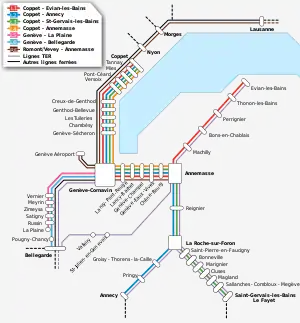
Geneva is linked to the rest of Switzerland with trains operated by the Swiss Federal Railways, with main lines towards Brig in the canton of Valais via Lausanne, to St. Gallen via Lausanne, Fribourg, Bern and Zurich or alternatively via Neuchâtel on the Jura Foot Railway, and to Lucerne.
Since 1984 the French high-speed trains (TGV) serve Geneva, with services connecting to Paris and as far as Marseille, operated by TGV Lyria, a joint company owned by the SNCF and the Swiss Federal Railways.
The public transport of Geneva is operated by Transports Publics Genevois, which on average carry a total of 200 million passengers per year on its extensive network of trams, trolleybuses, buses, and boats,[30] and by Lemanis, which operates the suburban rail network, the Léman Express. All the operators of the region operate under Unireso, so any ticket is valid in all the network within the canton as well as in France.
After the inauguration of the missing rail link between Geneva and the border French city of Annemasse and the creation of the Léman Express in 2019, many secondary bus routes were re-designed as feeders to the new train stations. Soon after the opening of the rail network and prior to the Covid-19 crisis in 2020, it had meet all its expectations in terms of passenger numbers with 25,000 daily users.[31] Several municipalities of the canton, especially those in the Mandement (Satigny, Russin, Dardagny), and those on the right-side of the lake (from Chambésy to Versoix) rely heavily on the rail for their commuting.
The tram network is also an important element of cohesion of the canton, linking the city of Geneva to its dense urban surroundings formed by large municipalities such as Lancy, Meyrin, Vernier, Onex or Bernex. Several extensions of the network are planned for the near future, including an extension towards the French city of Saint-Julien-en-Genevois via Plan-les-Ouates, and towards Grand Saconnex near the airport [32].
In 1964, the first Swiss motorway, the A1, was built between Geneva and Lausanne as part of the investments carried out for the Swiss national exposition of 1964, and later it was extended all the way to the border with Austria. The canton is also linked to the French motorway system with the A40 autoroute, offering a speedy access to the Mont Blanc tunnel.
Education
The main educational institution is the University of Geneva, founded in 1559 by John Calvin. It was originally called Schola Genevensis. The original buildings are no longer used by the University, and is now used by Collège Calvin.
The public system starts from the age of 4 in one of the 165 primary schools of the canton. This is followed in one of the 19 cycle d'orientation from the ages of 12 to 15. Students then choose to follow an academic route in one of the 11 collèges, or an apprenticeship/general studies in one of the 14 specialised schools.
In addition, the canton's private schools have a good reputation for academic excellence. Many of these schools, such as the International School of Geneva, and Institut Florimont, also offer the International Baccalaureate. This programme was founded in Geneva in the 1960s and it is still headquartered in the canton.
Culture
The Jeûne genevois is a public holiday specific to Geneva, celebrated on the Thursday following the first Sunday of September.
L'Escalade, or Fête de l'Escalade (from escalade, the act of scaling defensive walls), is an annual festival held in December in Geneva, Switzerland, celebrating the defeat of the surprise attack by troops sent by Charles Emmanuel I, Duke of Savoy during the night of 11–12 December 1602 (Old style). The celebrations and other commemorative activities are usually held on 12 December or the closest weekend.
References
- Arealstatistik Land Cover - Kantone und Grossregionen nach 6 Hauptbereichen accessed 27 October 2017
- "Ständige und nichtständige Wohnbevölkerung nach institutionellen Gliederungen, Geburtsort und Staatsangehörigkeit". bfs.admin.ch (in German). Swiss Federal Statistical Office - STAT-TAB. 31 December 2019. Retrieved 6 October 2020.
- According to the entry Genève (canton), in the Historical Dictionary of Switzerland.
- Return of Calvin, Archives of the Republic and Canton of Geneva.
- https://ge.ch/archives/12-traites-de-paris-de-turin
- https://www.admin.ch/opc/fr/classified-compilation/19560067/index.html
- Communiqué de la chancellerie d'Etat du 5 mars 2020, consulté le 5 août 2020.
- "Liste officielle des communes de la Suisse – 23.03.2017". Office fédéral de la statistique. Retrieved 27 November 2017.
- "Conseil d'État: Second tour de l'élection du Conseil d'Etat 2018" (official site) (in French). Geneva, Switzerland: République et canton de Genève. 6 May 2018. Retrieved 25 December 2019.
- "Conseil d'État: Législature 2018-2023" (official site) (in French). Geneva, Switzerland: République et canton de Genève. 2019. Retrieved 25 December 2019.
- "Grand Conseil: Député-e-s" (official site) (in French). Geneva, Switzerland: République et canton de Genève. Retrieved 25 December 2019.
- "Grand Conseil: Parlement cantonal" (official site) (in French). Geneva, Switzerland: République et canton de Genève. Retrieved 25 December 2019.
- "Election du Grand Conseil du 15 Avril 2018" (official site) (in French). Geneva, Switzerland: République et canton de Genève. 13 April 2013. Retrieved 25 December 2019.
- Condition pour l'aboutissement d'un référendum cantonal Archived 20 July 2011 at the Wayback Machine (in French). Retrieved 27 April 2011
- Condition pour l'aboutissement d'une initiative cantonale Archived 20 July 2011 at the Wayback Machine (in French). Retrieved 27 April 2011
- "Canton de Genève, Conseil national, 11 Sièges" (in French, German, and Italian). Neuchâtel, Switzerland: Swiss Federal Statistical Office. 18 October 2015. Retrieved 28 October 2015.
- "Council of States - Results: Geneva". Swiss Federal Confederation. 8 November 2015. Retrieved 28 October 2015.
- Nationalratswahlen: Stärke der Parteien nach Kantonen (Schweiz = 100%) (Report). Swiss Federal Statistical Office. 2015. Archived from the original on 2 August 2016. Retrieved 5 August 2016.
- Les binationaux dans le canton de Genève. Résultats du recensement fédéral de la population 2000, Communications statistiques n° 24 (PDF) (Report). OCSTAT, Geneva. 2005. Retrieved 12 May 2011. (in French)
- Population résidante permanente âgée de 15 ans ou plus selon la langue principale
- "Kirchenmitgliedschaft in der römisch-katholischen und evangelisch-reformierten Kirche nach Kantonen (2017)" (Table 1.4 on the lower part of the page) (in German). SPI St. Gallen. 2018. Retrieved 21 March 2019.
- "Statistiques cantonales – Les 21 domaines: 01. Population – Langues et religions" (official website) (in French). Geneva, Switzerland: StatistiqueGenève, République et Canton de Genève. August 2014. Retrieved 8 December 2014.
- "Languages and religions – Data, indicators: Religion" (official website). Neuchâtel, Switzerland: Swiss Federal Statistical Office. 2014. Archived from the original on 15 November 2014. Retrieved 8 December 2014.
- https://www.bfs.admin.ch/bfs/en/home/statistics/national-economy/national-accounts/gross-domestic-product-canton.html
- https://lenews.ch/2018/01/15/swiss-fact-nearly-50-of-swiss-gdp-comes-from-4-cantons/
- https://www.longfinance.net/media/documents/GFCI_27_Full_Report_2020.03.26_v1.1_.pdf
- https://stsa.swiss/knowledge/main-players/companies
- https://www.ge.ch/statistique/graphiques/affichage.asp?filtreGraph=06_02&dom=1
- https://swisswine.ch/fr/region/geneve
- https://www.tpg.ch/sites/default/files/2020-06/TPG-RAG2019.pdf
- https://www.lematin.ch/story/leman-express-25-000-passagers-par-jour-216497541131
- https://www.ge.ch/dossier/organiser-avenir-transports/developpement-du-reseau-tramway
External links
| Wikimedia Commons has media related to Canton of Geneva. |
- Official page (in French)
- Official statistics
.jpg.webp)
